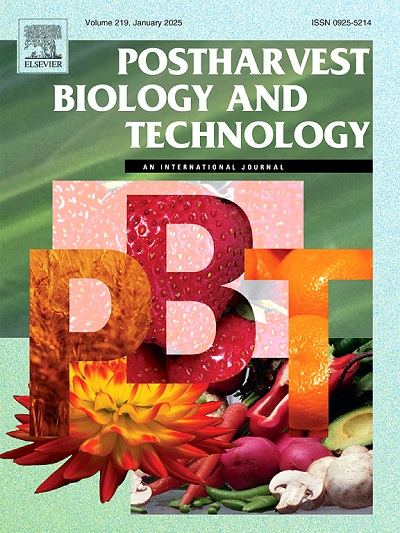野生叶菜贮藏期间的生化特征和品质变化:铜和抗坏血酸的拮抗作用
IF 6.8
1区 农林科学
Q1 AGRONOMY
引用次数: 0
摘要
野生叶菜因其丰富的植物化学成分和潜在的健康益处而成为传统饮食的重要组成部分。然而,它们在收获后的易腐性限制了它们的使用和商业潜力。本文研究了8种WLV的采后品质动态,重点研究了色素含量、总酚含量(TPC)和抗氧化活性等生化变化。此外,还探讨了酚类化合物、铜和抗坏血酸在组织褐变中的作用。结果突出了不同物种在采后行为上的显著差异。最显著的生化变化发生在收获后10天。黄绿丹始终保持较高的抗氧化品质,而马蹄草整体品质较好。与之相反,betonicifolium和Blitum - bonus-henricus表现出进进性退化。部分植物如千叶阿基那(Achillea千叶阿基那)和普通硅烯(Silene vulgaris)保持稳定但质量适中,而蒲公英(Taraxacum officinale)和车前草(Plantago lanceolata)的初始质量为次优,采收后质量恶化。该研究证实,铜和抗坏血酸在保存WLVs抗氧化剂中起拮抗作用:收获时较高的铜水平促进采后邻醌的形成,而抗坏血酸则发挥相反的作用。大多数被研究的物种都表现出在较长时间内保持质量的能力,这表明它们有机会更广泛地纳入可持续粮食系统。本文章由计算机程序翻译,如有差异,请以英文原文为准。
Biochemical profile and quality variations during storage of wild leafy vegetables: The antagonistic role of copper and ascorbic acid
Wild leafy vegetables (WLVs) are valuable components of traditional diets due to their rich phytochemical content and potential health benefits. However, their perishability after harvest limits their use and commercial potential. This study investigated the postharvest quality dynamics of eight WLV species, focusing on biochemical changes including pigment content, total phenolic content (TPC), and antioxidant activity. Additionally, the role of phenolic compounds, copper, and ascorbic acid in tissue browning was explored. The results highlighted significant differences among species in their postharvest behaviour. The most pronounced biochemical changes occurred ten days after harvest. Alchemilla xanthochlora consistently maintained high antioxidant quality, while Bistorta officinalis preserved better overall quality. Conversely, Phyteuma betonicifolium and Blitum bonus-henricus exhibited progressive deterioration. Some species, such as Achillea millefolium and Silene vulgaris, maintained stable but moderate quality, whereas Taraxacum officinale and Plantago lanceolata showed initial suboptimal quality that worsened postharvest. This study confirmed that copper and ascorbic acid play antagonist roles in preserving antioxidants of WLVs: higher copper levels at harvest enhance postharvest o-quinone formation, whereas ascorbic acid exerts an opposing influence. Most of the studied species demonstrated the ability to retain quality for extended storage periods, suggesting opportunities for their broader inclusion in sustainable food systems.
求助全文
通过发布文献求助,成功后即可免费获取论文全文。
去求助
来源期刊

Postharvest Biology and Technology
农林科学-农艺学
CiteScore
12.00
自引率
11.40%
发文量
309
审稿时长
38 days
期刊介绍:
The journal is devoted exclusively to the publication of original papers, review articles and frontiers articles on biological and technological postharvest research. This includes the areas of postharvest storage, treatments and underpinning mechanisms, quality evaluation, packaging, handling and distribution of fresh horticultural crops including fruit, vegetables, flowers and nuts, but excluding grains, seeds and forages.
Papers reporting novel insights from fundamental and interdisciplinary research will be particularly encouraged. These disciplines include systems biology, bioinformatics, entomology, plant physiology, plant pathology, (bio)chemistry, engineering, modelling, and technologies for nondestructive testing.
Manuscripts on fresh food crops that will be further processed after postharvest storage, or on food processes beyond refrigeration, packaging and minimal processing will not be considered.
 求助内容:
求助内容: 应助结果提醒方式:
应助结果提醒方式:


